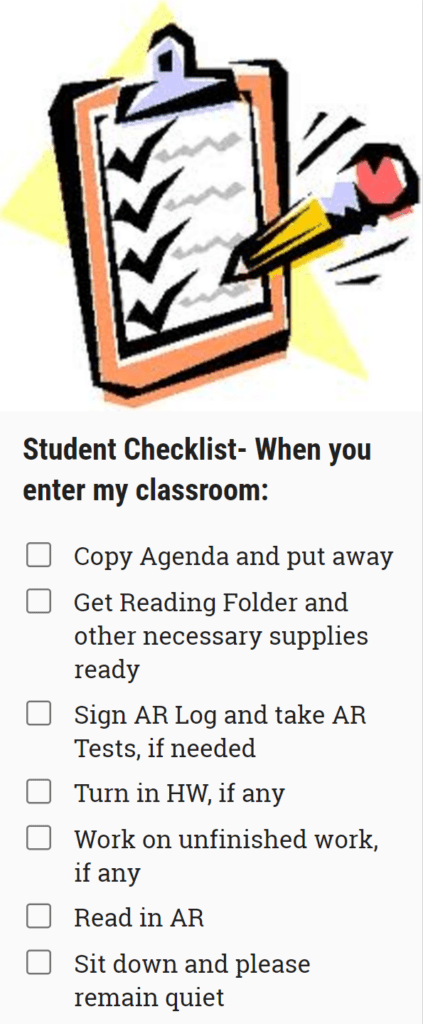“Used effectively, checklists can help students develop metacognitive awareness of their intellectual processes. Metacognitive research consistently suggests that students who know how to learn, know which strategies are most effective when faced with a problem or a task, and have accurate methods of assessing their progress, are better learners than those who don’t,” says Dr. Kathleen Dudden Rowlands (source). Several tools that can help with developing metacognitive awareness are available to educators and students. These tools can be used to create shared lists of tasks or instructions. In this blog entry, we will explore two tools available to schools.
Checklists for Metacognitive Awareness
“No matter how expert you may be, well-designed check lists can improve outcomes,” says Atul Gawande’s The Checklist Manifesto. If checklists can help students develop awareness of their thinking processes, then why aren’t more of us using them? In my own work as an educator, I quickly learned to keep a list of tasks. Checklists can help us manage the complexity that comes with learning new things, as well as sharing what we have learned.
You can find a wealth of checklists online at various Pinterest sites. Checklists are so important that the Federal Student Aid office, an office of the U.S. Department of Education, offers a variety of them .
For Students: Our checklists suggest these and many other steps you can take, as well as websites you can explore, as you prepare academically and financially for college.
For Parents: Each checklist—from elementary school through high school—includes items for you, such as how to support your child in his or her studies, where to set up a college savings account, and what to do when it’s time to apply for financial aid.
Simple, task-based checklists can empower and assist learners to follow steps and help them accomplish tasks with many steps, as well as serve as memory aids. Recognizing that checklists are important, here are two tools you can use to scaffold students’ list-making skills. (By the way, no one is born knowing how to make and keep a check list. This is a skill that we must teach our students and help them practice.)
Tool #1: Google Keep
Google Keep, which works on multiple devices, provides Post-It like simplicity. Some of its main features are listed below:
- Create and share checklists with colleagues, students, and others
- Quickly format a Google Keep note with a title and note contents
- Select a bright color for each note to distinguish them from each other
- Turn checkboxes on for your note to create a quick checklist or add dashes in front of notes to create a more impromptu list
- Draw on your Google Keep note with your finger or stylus
- Snap a picture or add an image from your device photo gallery
- Use images and pictures, one per note, to differentiate between your notes
- Grab the text from any picture, which is a quick way to use optical character recognition (OCR) to scan the image to text
- Use labels (a.k.a. tags or keywords) to organize notes
- Set reminders that will pop up. These reminders can be set to turn on based on time or your location (using GPS on your device).
- Collaborate with others on a note
- Copy a note to Google Docs if it becomes too long
Some features Google Keep lacks include formatting text (bold, italics, different fonts), nested checklists, the ability to embed more than one image, and adding documents as file attachments. You may want to read Eric Curts (Control-Alt-Achieve Blog) entry on interactive checklists.
Tool #2: Microsoft OneNote

Learning Tools add-on for OneNote
Available on all devices, Microsoft OneNote brings a host of features to the table. In addition to all the features that Google Keep has (albeit with no reminders feature or grab image text in the free OneNote version), OneNote has many more. Recently, it underwent a radical simplification from OneNote 2016 to the free OneNote app. Some of its newest features (although this list is not exhaustive) in August 2017 include:
- Text to Math: Use your keyboard to type an equation as text in OneNote, and use Math to solve it or draw a graph.
- Smart Lookup: Get definitions, wiki articles, and top related searches from the web without leaving OneNote
- Insert online pictures: Use Bing’s Image Search to safely insert photos and images without ever having to leave OneNote.
- Tables of all shapes and sizes: One cell or many? Choose the number of rows and columns you need to organize your content. Once you’ve got a table, you can add or delete rows or columns, add table shading, or sort your content.
- More highlight colors: Yellow isn’t the only color in the rainbow. Now you can highlight with blue, green, red, and more.
- Zoom in, zoom out: Use the new Page Width option on the View tab to zoom out to see all the notes on your page, or zoom in to focus on just what you need (source: Windows Central).
OneNote also now allows for Learning Tools, which includes the Immersive Reader. This add-on includes tools that read text aloud and more. While only available for OneNote Online and OneNote Desktop (a.k.a. OneNote 2016), it is hoped to soon be available for the free OneNote app. Another must-have add-on for schools includes Class Notebook. This add-on makes reviewing student work and distributing content to students easier.
Avoid Failure, Encourage Checklists
“Failure results not so much from ignorance as from ineptitude,” wrote Atul Gawande (source). He defined ineptitude as “not properly applying what we know works.” As we help students learn what to do, let’s also help them apply what we know works.

